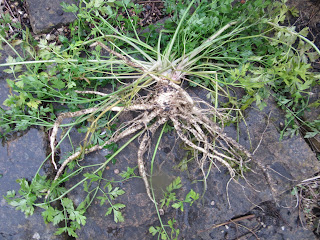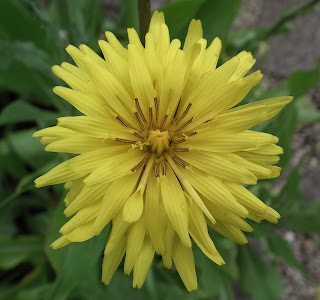Lessons To Learn
What Didn't Work
- Root vegetables - either just grow lots of leaves and no root (radishes, turnips, kohlrabi) or grow loads of roots turning them into demented underground spiders (see hamburg parsley photo above).
- Kalettes and swiss chard - need staking or supporting in some way in my soil, the kalettes fell over in the strong winds and one chard actually got torn from the ground.
- Tomatoes grown in the flower beds - too many leaves and not enough fruit.
- Flea beetles. My brassica leaves were constantly being turned into lace doilies. Contrary to what some books say I had the horrid little beetles all through the growing season. As my aim is to grow brassicas partly for their appearance, the usual response of covering them with enviromesh isn't really an option.
- Leek moth - destroyed my leeks last year..
- Generally - the garden was pretty crammed
What Worked Well
- Beans - borlotti beans were a revelation, as were freshly picked yellow french beans
- Lettuces and other salad leaves- the taste and texture of fresh lettuce is unlike anything you buy in supermarkets and there are so many to choose from
- Beetroot - not sure why this root veg worked when the others did not, but it did and my husband described it as a revelation (he particularly loved roasted beetroot)
- Young courgettes - picked when cigar-sized these were sweet and delicious
- Pea sprouts - the first plants I grew and I did so from some peas I bought in the dried food section in Morrisons.
- Balkinovy tomatoes - dwarf tomatoes grown in pots on the terrace.
- Coriander seeds - delicious sprinkled green and raw on salads
- Lidl salad and basil packs - I was able to break up these packs of small plants and grow them into full-size plants. Especially true of the komatsuna which is still flourishing in the garden
- Sunflowers - grew well even in the shadier part of the garden. Seeds were a lovely snack.
Lessons
- Many of my problems relate to the fact my soil is loam which is too high in nitrogen. There is not much I can do about that other than to grow plants that relish the high nitrogen - such as squashes and leaf vegetables.
- For the flea beetles I am going to try spraying with neem oil, an organic pesticide that is safe for bees.
- I really want to grow carrots, so I will do so in containers.
- I will grow tomatoes in pots and growbags. I will also try to provide them with covers to prevent leaf splash.
- To pack more plants in, I will be growing more plants upwards (winter squash, beans) and in containers. I have also cleared more beds, so I can grow fruit (rapsberries, whitecurrants, gooseberries, strawberries).
- I had the usual cabbage white caterpillars munching on kale and other brassicas, but ironically it was the plants that were under netting that were the worst affected, partly because it was harder to pick off the little beggars and partly because the wasps couldn't get in to kill them. I think I won't bother with netting next year and rely on the neem oil.
- I will be growing oriental brassicas later in the year (grown in the winter under cloches) to help avoid the dreaded flea beetle.



Comments
Post a Comment